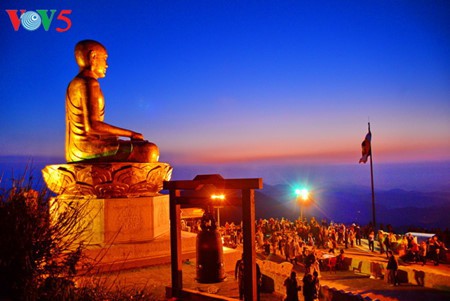For over 700 years, pilgrims have been making the journey to the top of Yen Tu mountain, experiencing the palpable history that surrounds them. Located in Thuong Yen Cong commune, Uong Bi district, in Quang Ninh province, Yen Tu is considered the birthplace of Vietnamese Buddhism. The landscape surrounding the mountain is known for its beauty and serenity, reflecting its religious significance.
Yen Tu is home to numerous historical relics, pagodas, towers, and now, luxurious accommodation at its base. One of the most popular times to visit is during the Yen Tu festival, which takes place from the 10th day of the first lunar month to the third lunar month of the Lunar New Year. During this pilgrimage, Buddhist dignitaries, monks, nuns, followers, and curious visitors come to pay homage to King Tran Nhan Tong, who reigned over Vietnam from 1279 to 1293 before dedicating his life to Buddhism.
Upon his arrival, Tran Nhan Tong founded Truc Lam Yen Tu, the first Vietnamese Buddhist Zen center. Under his leadership, thousands of followers were attracted to the sect, and hundreds of constructions were ordered on Yen Tu mountain. Prior to this, during the Ly Dynasty, the Phu Van pagoda was built on Yen Tu. The mountain continued to be a focal point of Vietnamese Buddhism during the Le and Nguyen Dynasties, undergoing various restorations.
A pilgrimage to Yen Tu typically begins at Giai Oan (Vindication) springs, where visitors can find a pagoda commemorating a group of imperial maids who allegedly committed suicide by diving into the river after pleading with King Tran Nhan Tong to return to the imperial palace. Since 2002, a cable car has been available for visitors to reach the mountain peak, offering a more convenient route than the six-kilometer track of slippery stone stairs that was previously used.
The cable car route starts at Giai Oan springs and goes to Hoa Yen pagoda. From there, visitors can continue to Mot Mai pagoda, where they can board the second cable car route, the Bach Long line, which takes them to An Ky Sinh’s statue. At an elevation of 400m, visitors can climb through the rocky and bamboo forest to reach Dong (Bronze) pagoda, which is located at the mountain’s peak, 1,068 meters above sea level. The pagoda, resembling a golden lotus, offers a serene and breathtaking view.
Yen Tu has been a significant Buddhist pilgrimage site since the 13th century, with its pagodas and religious relics serving as symbols of devotion and spirituality. Sitting at the top of Yen Tu, in front of Dong pagoda, one can experience a sense of tranquility and peace unlike anywhere else.
After descending the mountain, visitors have the option to explore the surrounding area. Following the old stone track from Bronze pagoda down to Giai Oan springs, amidst bamboo forests and century-old pine trees, provides a different perspective of the mountain. Along the way, visitors can admire the Buddha statue cast from 138 tons of copper and visit other significant landmarks such as An Ky Sinh Temple, Van Tieu pagoda, Bao Sai pagoda, the One-roofed pagoda, and Hoa Yen pagoda.
Despite the decrease in foot traffic along this route due to the availability of the cable car, there are still locals, such as Toan, who maintain businesses or kiosks to provide rest and refreshments for visitors. Toan, who lives in the “land of Buddha,” believes in living with good behavior and continues to serve those who choose to climb the mountain without the aid of the cable car.
The journey down the mountain may be wet and dark, but the sense of calm and peace remains. One can easily imagine how monks in the 13th century found enlightenment in such a place. It is a regret that one writer’s grandmother, who inspired their visit, was unable to witness the luxuries and convenience that the cable car now offers. Despite this, their grandmother’s unwavering belief and faith gave her the strength to climb to the top of Yen Tu mountain at the age of 80.




